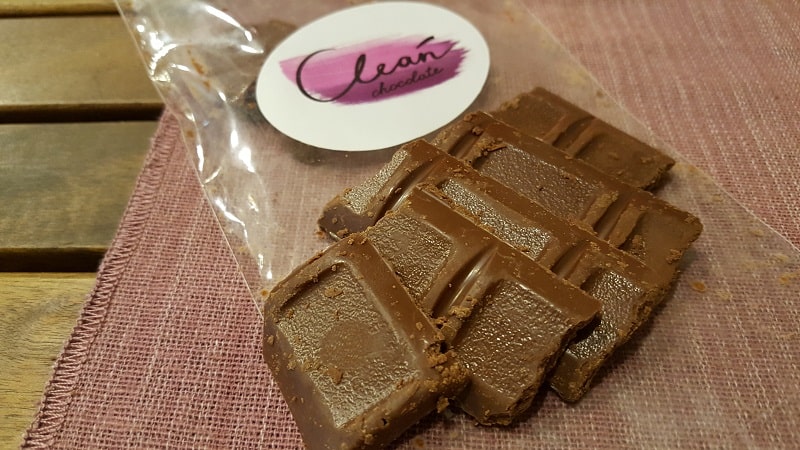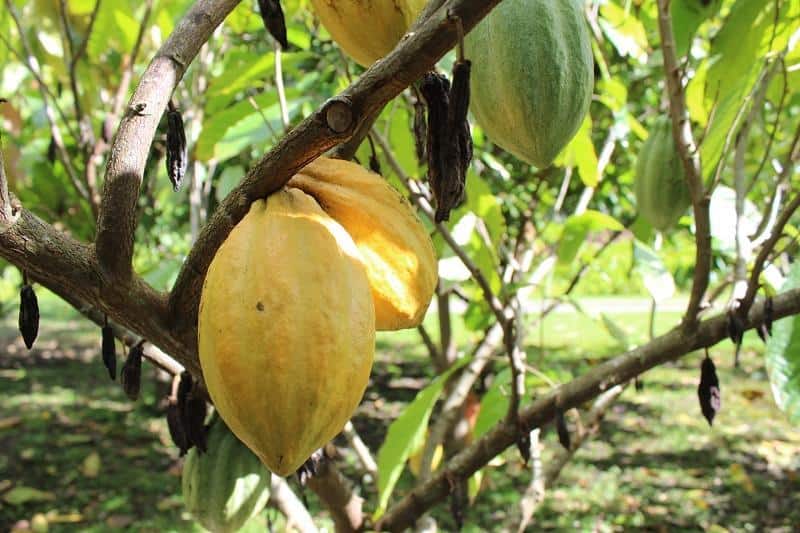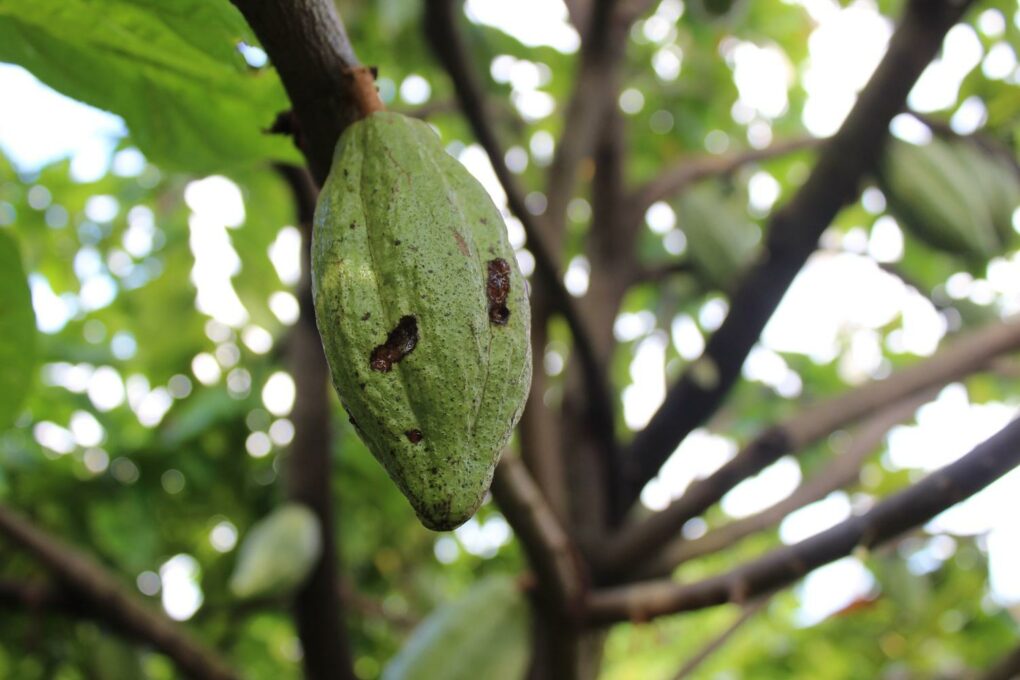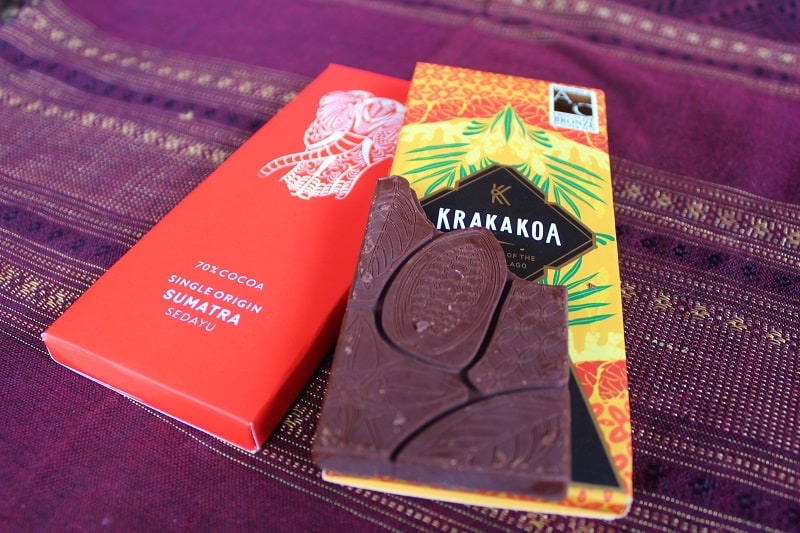Contrary to popular belief, chocolate is not native to Belgium or France. In fact, it wasn’t introduced to Belgium or France— or anywhere else in Europe for that matter— until just a few centuries ago.
For thousands of years before that, chocolate was only consumed in parts of modern-day Mexico and Central America, and in parts of northern South America. But even the chocolate we eat these days is different from the cacao drinks they consumed back then.
Modern chocolate is a bittersweet treat that’s made by grinding & sweetening the fermented and roasted seeds of the tropical cacao tree. It’s made in almost every country in the world, and over 50 countries grow the cacao used to make chocolate.
So where does chocolate come from, these days? It depends on what you mean.

Chocolate is from a long history in the Americas, and then Asia and Africa. It’s also from the cacao grown in most tropical regions in the world, and is made and shipped from almost every country.
Once a chocolate maker has roasted and ground their cacao seeds, the ground cacao is now known as chocolate liquor, and can be hardened in molds to create baking chocolate. More commonly it is pressed to reduce cacao butter content (the fat of the cacao bean) and then crushed to make cacao powder.
Alternatively, makers produce semisweet chocolates, using sugar and extra cacao butter ground with chocolate liquor. Adding dried milk powder or concentrated milk to sweet-chocolate results in milk chocolate, of which there are numerous dairy-free variations.
But the creation of any chocolate starts with the cacao beans. Obtaining cacao beans involves a long slow manual labor process which will be explained in more detail below. Cacao beans (also referred to as cocoa beans) are harvested from the fruit of a tree called Theobroma cacao, which is native to the tropical regions of modern-day South America.

How is Chocolate Made (From Bean to Bar)
Harvesting Cacao
It takes 2-4 years for trees to mature and start to bear cacao fruit, in the form of colorful elongated pods. Each tree can yield many dozens of fruits annually and take 6 months to ripen from flower to mature pod.
Harvesting can be done throughout the year, the bulk of which is done twice, between October to February and May to August depending on the region. Once harvested, cacao fruits are individually taken from the trees and cut open with machetes to get at their ripe seeds (from then on referred to as cacao beans) and pulp.
The extracted beans and pulp are piled onto leaves or leaf-lined holes/containers that have been perforated to drain excess liquids from the bottom.
Fermenting Cacao
The beans are fermented along with their pulp and require periodical turning to dissipate heat. The increased heat kills the germ in the seed and drains the pulp’s sweating.
The duration they are left fermenting depends on the category of the cacao bean. More heavily Forastero-dominant types are usually fermented for 5 to 7 days while Criollo-heavy types are left between just 1 to 3 days.

Drying Cacao
After fermentation, the beans are laid out in the sun to dry slowly or heated artificially with a kiln. Drying reduces the moisture content of the bean from 60% to 7% and helps it form a resistance against mold.
The speed at which they dry should be slow enough to prevent premature hardening of the shells that could trap unwanted moisture and leave the beans tasting acidic.
Generally sun-drying is enough for this, but sometimes artificial drying is employed to avoid mold formation. After the drying process, the beans are loaded into sacks for storage or delivery.
When chocolate’s popularity spread to the Western World, so did the demand for cacao beans. Spain, along with other colonial powers, opted to use slave labor in their colonies from their inception, to grow and meet the rising demand.
African slaves eventually replaced the declining labor force from conquered Mesoamerican civilizations. Today West Africa is responsible for ⅔rd of global cacao production and continues to supply the worldwide chocolate manufacturing industry, serving as an economic reminder of the long-lasting impact of colonial slave labor.

Where Does Cocoa Come From?
Chocolate is made from grinding a tropical seed known as the cacao bean. Cacao is grown in 50+ countries in tropical parts of the Americas, Africa, Asia, and the South Pacific.
There are now recognized to be ten distinct types of genetic families within the cacao species, but most people still think of cacao types in 3 general categories: Forastero, Criollo, and Trinitario.
Forastero
Forastero cacao accounts for 80-95% of global cacao production and is the most used type in commercial chocolate production. It is one of the 10 genetic families native to the Amazon, and is grown throughout West Africa, Ecuador, and Brazil, among others.
Forastero pods are often yellow, high-yielding, and disease resistant. The pods are short, smooth, and have shallow ridges. The beans themselves have a purple color when cut in half, and are bitter and acidic in taste, though to be due to their polyphenol content.

Criollo
Criollo cacao makes up only 5% of all cacao production, and is also one of the ten distinct genetic families of cacao. The pods are long, often colored light green, and have deep ridges.
Criollo cacao yields fewer beans which are smaller and predominantly white, and are unfortunately more susceptible to attacks from disease and pests. They are the most expensive variety of cacao due to their rarity, low yield, and complex flavor. Most criollo cacao is grown in Central America or northern South America, where it’s native.
Trinitario
This cacao is a hybrid between the Forastero and Criollo cacaos. Trinitario types yield more beans than criollo while maintaining relatively higher resistance to pests and diseases.
The varietal is actually an amalgam of many different genetic families, but is named after the island of Trinidad, where it was created as insurance against potential loss due to invasive fungus (which has happened). It’s hardy with an aromatic scent and a more fruity taste than Forasteros, but still makes up less than 10% of global production.

Where is Chocolate Made?
Early chocolate consumption was in beverage form. The industrial revolution in the 1800s, as well as a series of developments in machinery, would introduce methods that helped to transition chocolate from a drink to a food.
European and Western Nations would be the first to show great interest in chocolate on a large scale, specifically within Spain, England, France, and the United States.
Chocolate's massive growing popularity between the 1600s and 1800s led these regions to become the primary and most internationally well-known manufacturers of commercial chocolate goods.
Unfortunately, this expansion in the interest of chocolate inevitably also relied on the slave trade and cheap labor to supply the increasing demand for cacao beans. Since the beginning of cacao production in the colonies, farmers and laborers faced stiff competition and lived on low wages.
To this day cases of child labor and human trafficking can be linked to the demand for cacao production for export to global chocolate manufacturers. As it turns out, much of the revenue in chocolate comes from the sale of finished products, much like in most industries.
Former colonies have recently started to get involved in local refining and production of commercial chocolate goods, with some larger deals in the works with the permission of the government.
The hope is that entering the refining and processing sector of the industry will allow them to capture additional value from their locally-grown cacao.

A Brief History of Chocolate
The history of chocolate is long and predates written records. There is ancient pottery found in Ecuador with signs of cacao residue dating back over 5000 years ago, actually the oldest evidence of cacao consumption on the planet.
Research into Mesoamerican civilizations suggests that in somewhat more recent history, up north the Maya, Aztecs, and Toltec valued cacao beans and chocolate for more celebratory reasons.
In those societies, chocolate is believed to have been used for ceremonies and even enjoyed in everyday life. The Aztecs adopted cacao as a beverage and sweetened their chocolate drinks with honey.
Cacao's prevalence in certain areas of these civilizations also suggested that the beans were used as a form of currency, in addition to being consumed.

History of Chocolate After 1492
In the year 1502, on the fourth voyage of Christopher Columbus, the Spanish intercepted cacao beans and took them back to Spain. The plant would see initial use as a medicinal drink due to its bitterness, but would later be enriched with sweeteners such as sugar, honey, cinnamon, and vanilla.
In 1585 Spain recorded the first shipment of cocoa beans arriving from Veracruz, Mexico.
But it would not be until 1606 that chocolate saw its introduction into Italy, and eventually the rest of Europe. In 1765 chocolate manufacturing would begin in the American colony of Massachusetts, using cacao beans from the West Indies.
Heading into a new era of global innovation, in 1815 Coenraad van Houten from the Netherlands reduced the bitterness of chocolate by adding alkaline salts. He then created a press in 1828 that removed half the natural fat from cacao butter, improving chocolate's consistency and aiding in the invention of cocoa powder.
Both of these innovations greatly moved the popularity of chocolate forward by making it much more affordable.

History of Chocolate Bars
In 1847 British chocolate company J.S. Fry and Sons jumped history forward again when they molded the first chocolate bar by adding sugar and cocoa butter to pressed chocolate liquor. This would serve as the template for future chocolate confections, and this portable chocolate would become incredibly popular.
In 1876 a Swiss national, Daniel Peter, would then add milk powder (developed by Henri Nestlé) to the mix to create milk chocolate. Soon after, in 1879, the Swiss national Rudolf Lindt invented the conch machine, now commonly used to mix & aerate chocolate to further refine its texture.
These contributions would shape the foundations of modern chocolate manufacturing and only expand to the corporations behind household brand names we know today, such as Nestlé, Cadbury, The Hershey Company, Mars, Incorporated, Lindt, and more.

















Comments
No Comments